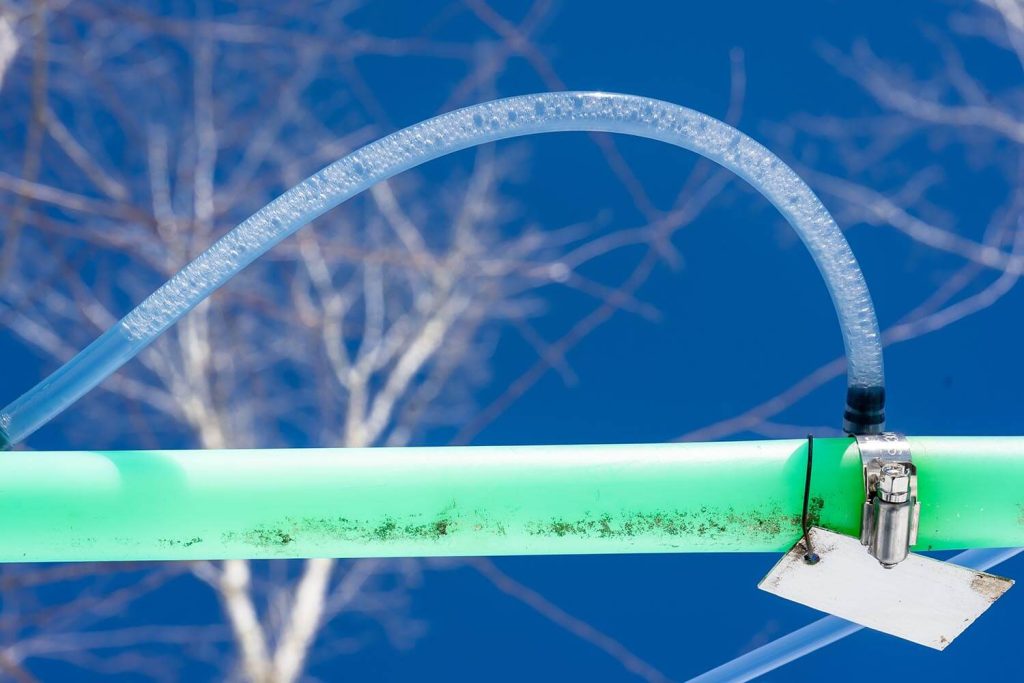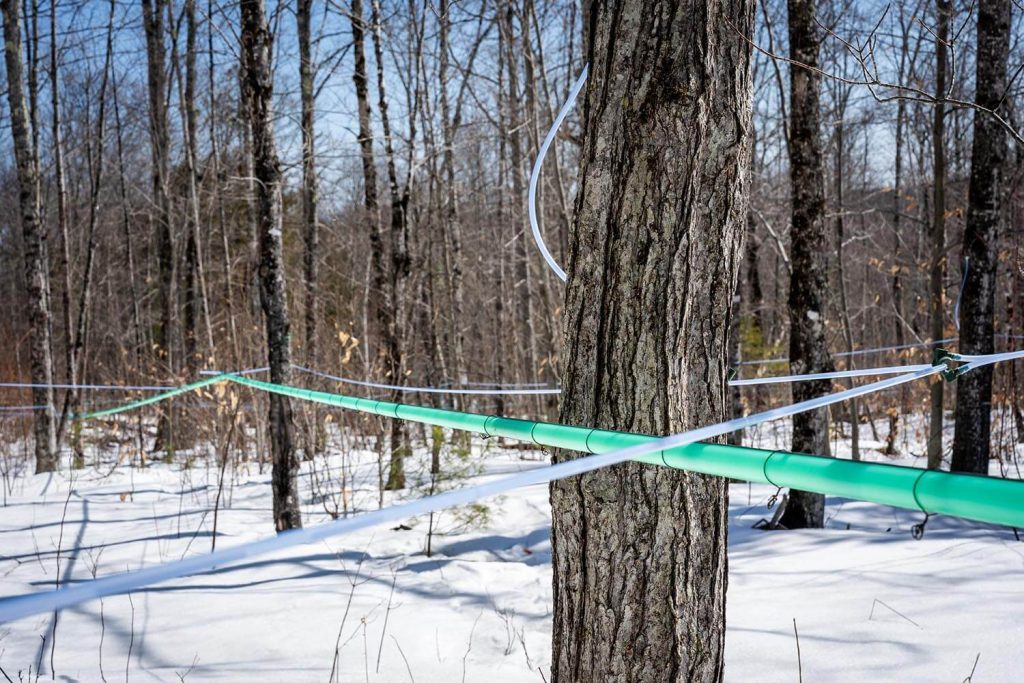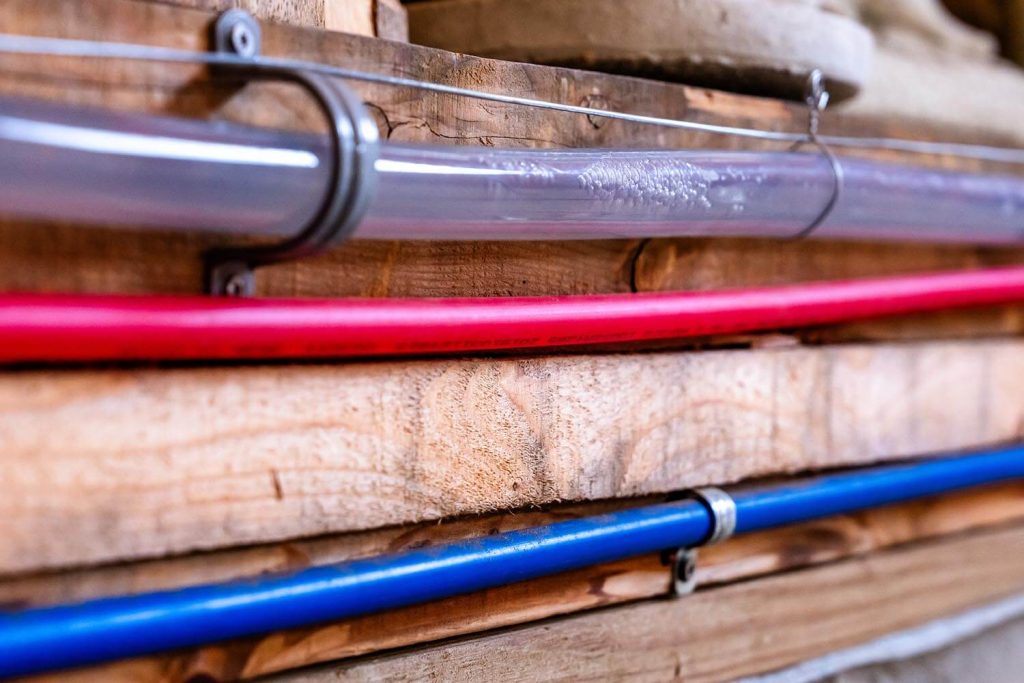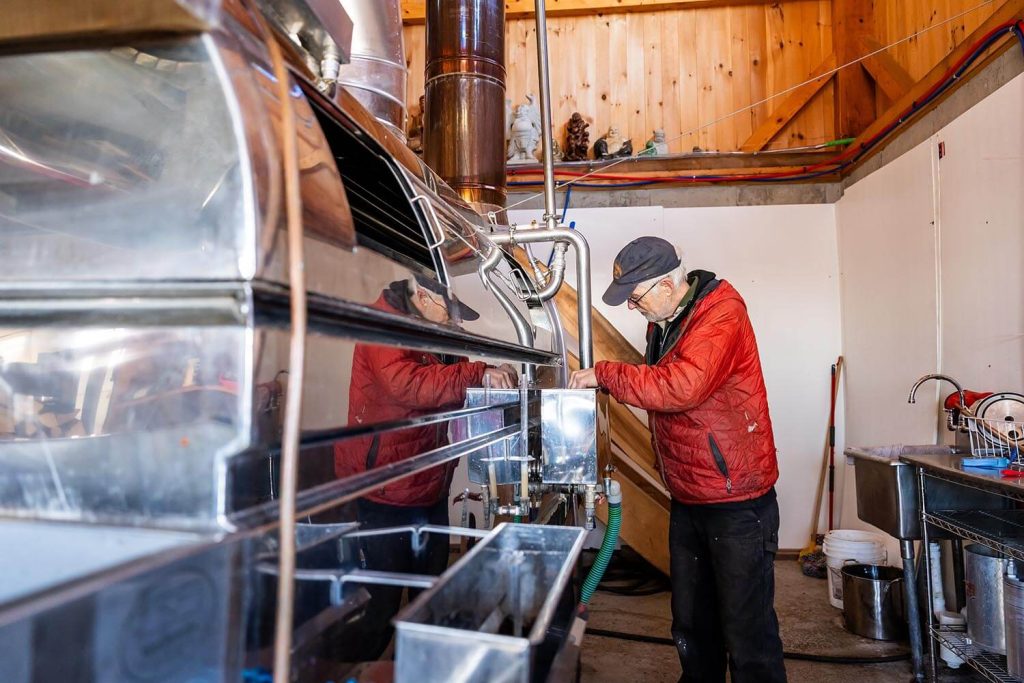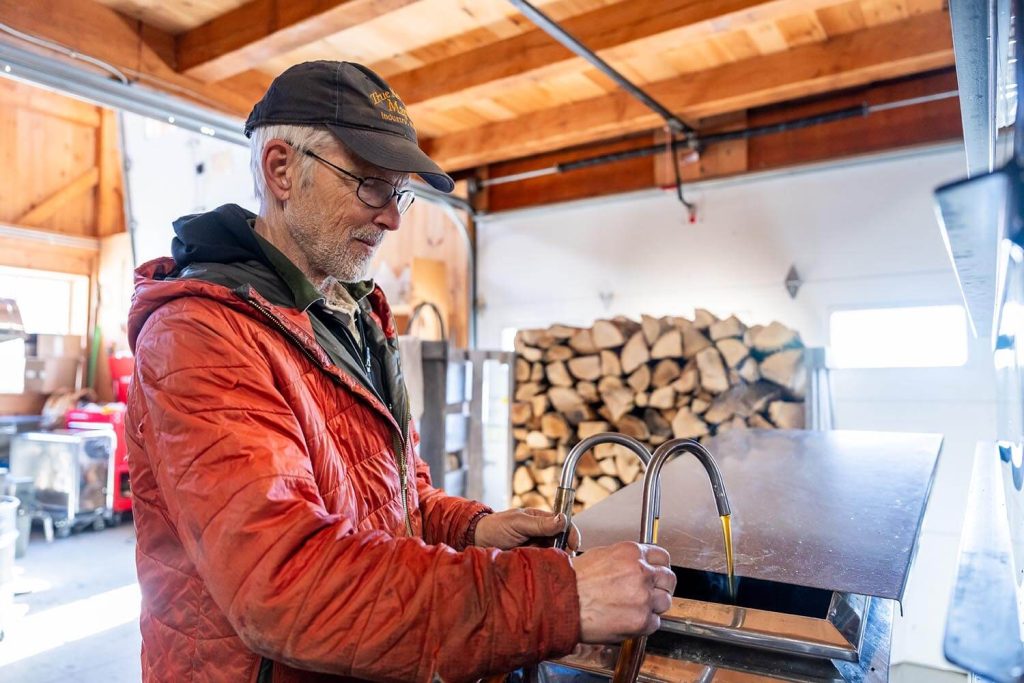
Tapping for gold: UMaine research fortifies state’s maple industry
It’s late spring, and the leaves on Maine’s maple trees are full – the buds have swelled, and the season for collecting sap is long over.
Maine maple sugar producers, like Mark Prentiss and Kim Roberts, are already at work preparing for next year’s sap-collecting season. Prentiss and Roberts, who are married, are co-owners of True Mountain Maple, a small maple sugar production facility in the western Maine town of Industry, just north of Farmington.
Prentiss said that during late winter, sap that has been stored and frozen in tree trunks and roots rises and begins the process of emerging from dormancy. When the trees experience enough warm weather, buds use energy from the sap to form new leaves.
In order for good sap to flow, temperatures have to be below freezing overnight and around 40-50 F during the day. But over the past couple of decades, Prentiss and Roberts, as well as other maple industry stakeholders, have observed that the time period has become increasingly varied from year to year. It affects the profitability and success of a maple season and is completely beyond the control of sugarmakers.
Researchers at the University of Maine, including Jason Lilley, a maple industry educator and assistant extension professor with University of Maine Cooperative Extension, and Jessica Leahy, Henry W. Saunders Distinguished Professor of Forestry in the School of Forest Resources, are launching a research and outreach program to help the industry adapt to stressors enhanced by Earth’s changing climate.
“The difference between 37, overcast and windy and 39 and sunny, that’s the difference between sap running and not running,” Lilley said. “So it’s these very minor differences that are influencing what our year is going to be like.”
Lilley works with Sean Birkel, Maine state climatologist and assistant professor with a joint appointment to UMaine’s Climate Change Institute and UMaine Extension, to get a sense of general trends in upcoming maple seasons. On average, sap is collected for about four-to-eight weeks every year. The season is over when high temperatures reduce the quality of sap or when nighttime temperatures stay above freezing and stop sap from flowing.
“Many of Maine’s forests are facing challenges like pests and diseases, droughts, extreme rainfall events and wind storms,” said Leahy, Lilley’s research colleague. “We want to help sugarmakers and sugarbush managers respond to these, because maple is not only an important industry within Maine’s forest economy, it’s a part of our state’s culture.”
Maine’s maple industry employs over 800 people in part and full time positions and has an estimated annual statewide economic contribution of $82.5 million — $55.6 million in output and $26.6 million in labor income. The state’s 500 licensed producers have been in business for an average of 21 years.
Prentiss and Roberts started True Mountain Maple eight years ago as a small-scale passion project. Now they have nearly two miles of tubing lines and around 3,600 taps. Every sugar maple on the property is tapped and connected, except “Sawyer’s trees” at the front, where a bucket collects sap for Prentiss’ grandson.
Prentiss, whose family purchased the property in 1930, and Roberts knew when they commercialized and opened True Mountain Maple that production would be different every year, but Roberts said it is getting more unpredictable. Their 2025 season started weeks later than usual, which Roberts attributed to a cold February. However, they processed 1,250 gallons of maple syrup in just over a four-week period compared to 1,240 gallons over seven weeks last year.
Lilley said this year’s season lasted just four weeks for most Maine producers, yet resulted in record yields. Despite the late start, temperatures stayed in the ideal production zone with just a few days that were too warm. Typically, extended periods of freezing temperatures stall midseason production, but producers collected sap nearly every day this year.
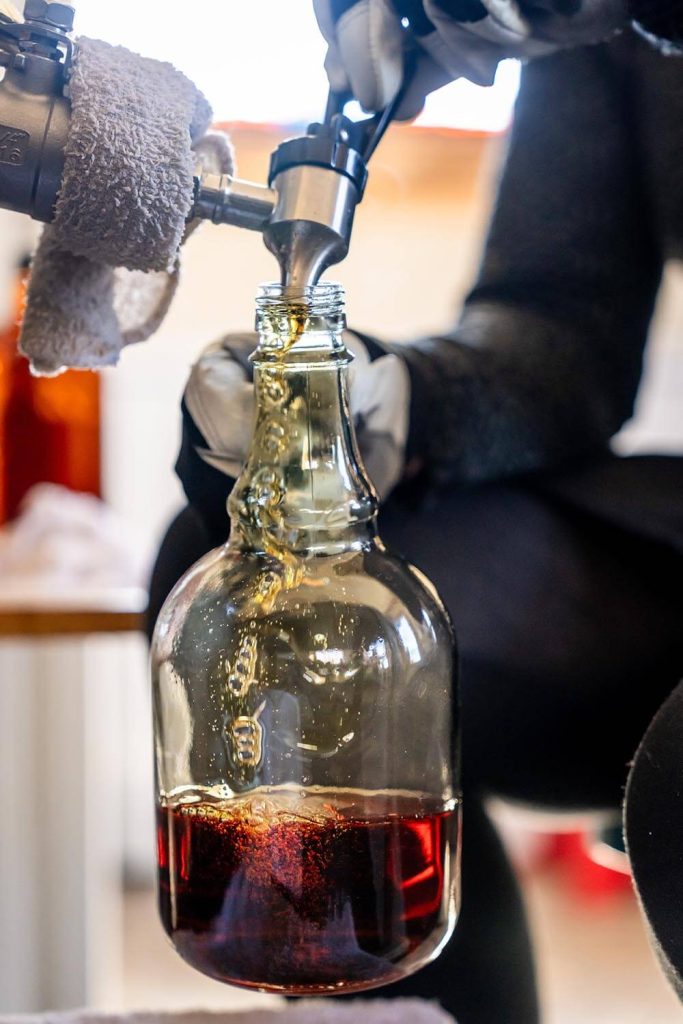
Roberts said productive, short windows for processing sap puts added stress on operations like True Mountain Maple, in which just two or three people are working.
In addition, Prentiss has noticed areas of the sugarbush where trees are stressed or dying. These patches increased after the abnormally dry years of 2020-22. Heavy rainfall has also damaged access roads on their mountainside sugarbush.
To minimize stress and enhance the ecosystem, Prentiss and Roberts have worked with a forester to develop a forest management plan and have implemented those plans to thin the trees and increase diversity of tree species.
“Basswoods are really good trees to have in your forest because bees love them,” Prentiss said. “They’re good diversity. You don’t want to make it a monoculture.”
Lilley first toured True Mountain in 2023 to learn about Prentiss’s and Roberts’s management approaches and provide insights on additional best practices. He and Leahy are planning an in-depth, three-part micro-credential course to train sugarbush managers, consulting foresters and other technical advisors about some of the sustainable practices used at True Mountain Maple, which can help create more resilient forests.
“When there’s a big wind storm that comes through, as an example, if there are other types of trees in the woods that are more deeply rooted, that can withstand those winds, versus these shallow rooted sugar maples, they are all going to have a higher chance of not getting knocked over,” Lilley said.
A severe hurricane in Nova Scotia in 2019 destroyed an estimated 25% of the province’s maple trees and caused maple businesses to default. While this hasn’t happened to this extreme in Maine, Lilley said that over the past several years, extended periods of drought and flooding, ice storms and strong wind have damaged forest health.
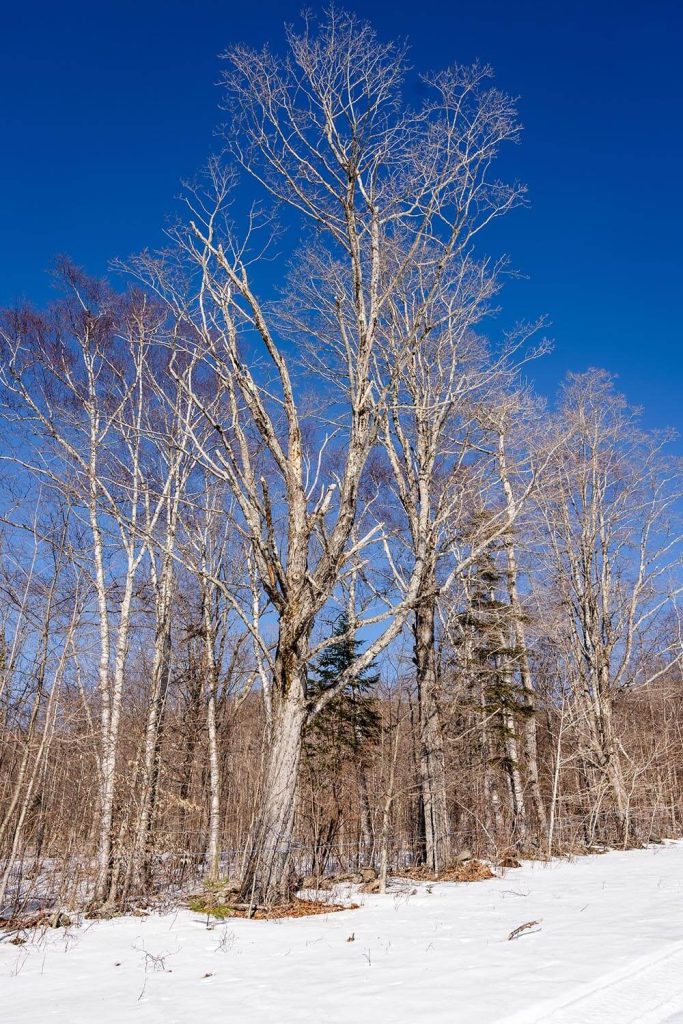
As part of their research and outreach, Lilley and Leahy will record the perceptions and experiences of Maine maple producers regarding how the weather in recent years has impacted their sugarbushes, which will help establish a baseline for management strategies. This program, funded by a $481,691 grant through the U.S. Department of Agriculture, is a collaboration with two faculty from the University of Vermont Cooperative Extension, an assistant Extension professor of forestry and a maple specialist, and is an educational opportunity for anyone — business owners, students, consulting foresters or backyard sugarmakers.
In addition to the micro-credential course, which is curricula focused on workforce development and offered to students and professionals, Lilley and Leahy will host a series of public workshops on sugarbush management strategies.
This grant is one of several from the USDA in the past decade to support maple syrup production through UMaine research. A separate project from Leahy aimed to strengthen rural communities by addressing beekeeping and maple production challenges, and research from the School of Food and Agriculture aims to expand the domestic market for maple products.
Contact: Ashley Yates; ashley.depew@maine.edu

